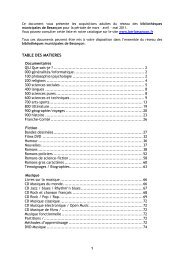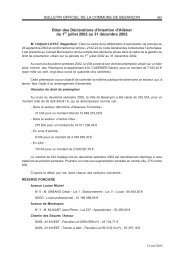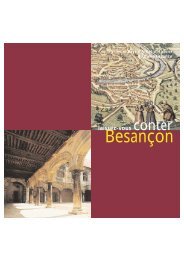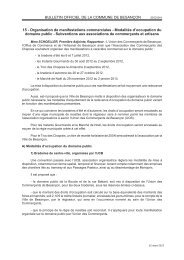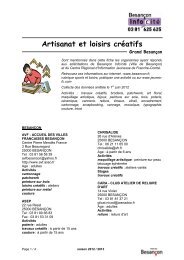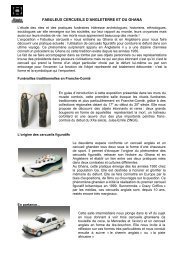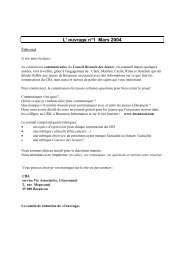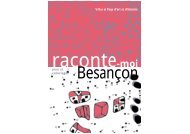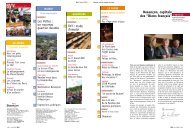An inventory of works within the city walls - Besançon
An inventory of works within the city walls - Besançon
An inventory of works within the city walls - Besançon
You also want an ePaper? Increase the reach of your titles
YUMPU automatically turns print PDFs into web optimized ePapers that Google loves.
Charmont demi-lune<br />
Built between 1677 and 1679,<br />
it was restored in <strong>the</strong> nineteenth and<br />
<strong>the</strong> twentieth centuries at <strong>the</strong> time <strong>of</strong><br />
<strong>the</strong> road improvements. It protected<br />
<strong>the</strong> porte de Charmont which was<br />
destroyed in 1894 and gave access<br />
to <strong>the</strong> town.<br />
Fort Griffon<br />
23 24<br />
Seventeenth and nineteenth centuries<br />
Seventeenth and nineteenth centuries<br />
Avenue de la Paix<br />
Place Griffon<br />
24<br />
The current fort was built as from 1680<br />
on Vauban’s plans. It succeeded a first<br />
bastion which might have been built<br />
in 1595 by Italian engineer Jean<br />
Griffoni, when <strong>the</strong> troops <strong>of</strong> <strong>the</strong> king<br />
<strong>of</strong> France Henry IV were threatening<br />
to lay siege to <strong>Besançon</strong>. This fort,<br />
<strong>the</strong> town’s bridgehead, which occupied<br />
a prime location, might be considered<br />
a second citadel. It served <strong>the</strong> function<br />
<strong>of</strong> a redoubt holding a key position<br />
on <strong>the</strong> right bank and its design enabled<br />
firing both out into <strong>the</strong> countryside in<br />
<strong>the</strong> event <strong>of</strong> attack, and over <strong>the</strong> <strong>city</strong> in<br />
<strong>the</strong> event <strong>of</strong> an uprising « It alone, with<br />
a garrison <strong>of</strong> just 200 men would better<br />
contain <strong>the</strong> population than 1200<br />
accommodated in ordinary barracks. »<br />
23<br />
wrote Vauban. With three bastions<br />
one with a cavalier. It had an entrance<br />
gate which, up to <strong>the</strong> beginning <strong>of</strong> <strong>the</strong><br />
twentieth century, was protected by a<br />
ditch, now filled in, and equipped with<br />
a drawbridge. The courtyard in which<br />
<strong>the</strong> chapel was built is surrounded<br />
by three ranges <strong>of</strong> buildings. Two <strong>of</strong><br />
<strong>the</strong>m are barracks built in accordance<br />
with <strong>the</strong> modular barracks prototype,<br />
Vauban style, <strong>the</strong> second included<br />
<strong>the</strong> guardhouse as well as <strong>the</strong> fort<br />
commander’s accommodation.<br />
Designed to accommodate <strong>the</strong><br />
troops, Fort Griffon was used by <strong>the</strong><br />
military until 1945 <strong>the</strong>n from 1946<br />
it was used as a school. It is now<br />
one <strong>of</strong> <strong>the</strong> buildings <strong>of</strong> <strong>the</strong> Teacher<br />
Training University Institute <strong>of</strong><br />
Franche-Comté. Fort Griffon was listed<br />
as a historical monument in 1944.<br />
22



